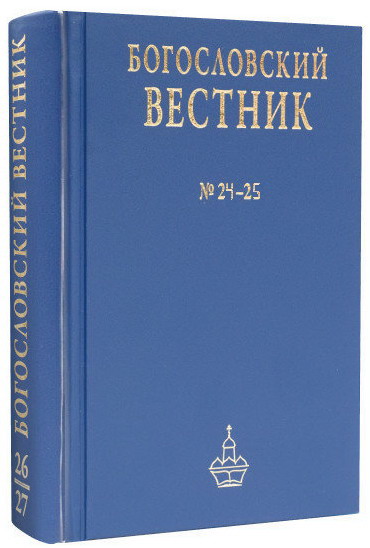An overview of some of the new paleo‑anthropological discoveries in the context of science and biblical apologetics
Keywords:
anthropogeny, apologetics, science and religion, paleoanthropology, the Flood, the oldest man, the homeland of mankindAbstract
The proposed review is based on a number of publications found at: “Antropogenez.ru”, “Elementy.ru”, “Public Library of Science” (PLоS) and other sources. The challenge of Orthodox biblical apologetics is to interpret scientific facts in the framework of the traditional Christian view of the history of mankind. Of course, it is necessary to consider the fundamental difference between the reasons for which a Supernatural revelation was given to us in the form of Scripture, and scientific research in the field of paleoanthropology, archaeology, genetics. However, it is possible and very important to reflect on the meaning of the biblical-theological content in light of the interesting factual material accumulated by the labors of scientists of different directions in recent years.
Downloads
References
Соколов А. Б. 100 лет спустя Крапина преподносит сюрпризы. Древнейшее ожерелье из когтей. URL: http://antropogenez.ru/single-news/article/467/ (дата обращения 16.06.2017)
Radovcic D., Srsen O. A. et al. Evidence for Neandertal Jewelry: Modified White-Tailed Eagle Claws at Krapina // Public Library of Science One, March 11, 2015. URL: http://journals.plos.org/plosone/article?id= (дата обращения 16.06.2017). DOI: 10.1371/journal.pone.0119802
Неандертальцы строили кольца из сталагмитов внутри пещер. Обзор. URL: http://apxeo.info/gominidy-2/neandertalcy-stroili-kolca-iz-stalagmitov-vnutri-peshher.html (дата обращения 16.06.2017).
Соколов А. Б. Доисторический детектив. Кто убил человека из Сима де лос Уэсос? URL: http://antropogenez.ru/single-news/article/483/ (дата обращения 16.06.2017)
Sala N., Arsuaga J. L., Pantoja-Perez A. et al. Lethal Interpersonal Violence in the Middle Pleistocene // Public Library of Science One. Published: May 27, 2015. URL: http://journals. plos.org/plosone/article?id= (дата обращения 16.06.2017). DOI: 10.1371/journal.pone.0126589
Вонг К. Самый маленький человек // В мире науки: Палеоантропология. 2005. № 5. URL: http://www.sciam.ru/2005/5/paleoantology.shtml (дата обращения 16.06.2017)
Соколов А. Б. Homo floresiensis: 3:2 в пользу микроцефалии… URL: http:// antropogenez.ru/single-news/article/119/ (дата обращения 16.06.2017)
Vannucci R. C., Barron T. F., Holloway R. L. Craniometric ratios of microcephaly and LB1, Homo floresiensis, using MRI and endocasts. PNAS. 2011. August 8. URL: http://www.pnas.org/content/ 108/34/14043.abstract (дата обращения 16.06.2017)
Falk D. et al. Brain shape in human microcephalics and Homo floresiensis // PNAS USA. 2007. Vol. 104. P. 2513-2518. URL: http://www.pnas.org/content/104/7/2513.full (дата обращения 16.06.2017)
Соколов А. Б. ДНК хоббита: новая надежда. URL: http://antropogenez.ru/single- news/article/54/ (дата обращения 16.06.2017)
Наймарк Е. Б. «Хоббиты» с острова Флорес оказались вчетверо старше. URL: http:// elementy.ru/novosti_nauki/432728/Khobbity_s_ostrova_Flores_okazalis_vchetvero_ starshe/t162677/Paleontologiya (дата обращения 16.06.2017); Sutikna, Tocheri 2016
Lari M., Vincenzo F., Borsato A. et al. The Neanderthal in the karst: First dating, morphometric, and paleogenetic data on the fossil skeleton from Altamura (Italy) // Journal of Human Evolution. Vol. 82. May 2015
Деревянко А. П. Родословная человечества: теории и факты. URL: http://elementy.ru/ nauchno-populyarnaya_biblioteka/431435/Rodoslovnaya_chelovechestva_teorii_i_fakty (дата обращения 16.06.2017)
Головина Е., Граб Д. Денисовские люди. URL: https:// scientificrussia.ru/articles/denisovskie-lyudi (дата обращения 16.06.2017))
Наймарк Е. Б. У алтайских неандертальцев найдены гены архаичных сапиенсов, а у денисовцев - гены гейдельбергских людей. URL: http://elementy.ru/novosti_ nauki/432699/U_altayskikh_neandertaltsev_naydeny_geny_arkhaichnykh_sapiensov_a_u_ denisovtsev_geny_geydelbergskikh_lyudey (дата обращения 16.06.2017)
Коньков А. Расшифровка древней ДНК рассказала о происхождении южноамериканских индейцев. URL: http://elementy.ru/novosti_nauki/432739/Rasshifrovka_ drevney_DNK_rasskazala_o_proiskhozhdenii_yuzhnoamerikanskikh_indeytsev/t125949/ Antropologiya (дата обращения 16.06.2017); Llamas, Fehren-Schmitz, et al. 2016
Библия. Книги Священного Писания Ветхого и Нового Завета. М., 1990
Вишняцкий Л. Б. История одной случайности или происхождение человека. Фрязино, 2005
Контекст: ...могли обрести себя изгнанными в иной 6 Гешер Бенот Йаков 1 и 2 / Gesher Benot Ya'acov 1, 2 // Антропогенез.ру / Каталог находок / URL: http://antropogenez.ru/location/100/ (дата обращения 16.06.2017) 7 Вишняцкий 2005...
Глаголев С. С. О происхождении и первобытном состоянии рода человеческого. М., 1894
Мумриков О., свящ. Концепции современного естествознания: христианско-апологетический аспект. Учебное пособие для духовных учебных заведений. Сергиев Посад - М., 2014
Arsuaga J. L., Martínez I. et al. Neandertal roots: Cranial and chronological evidence from Sima de los Huesos // Science. 2014. № 344 (6190). P. 1358-1363.
Czarnetzki A. The unravelled LB1 (Homo floresiensis) riddle? Some critical comments on the morphology of LB1 // Archäologische Informationen. 2015. Bd. 37. S. 181-189.
Delfino P. V., Vacca E. Report of an archaic human skeleton discovered at Altamura (Bari), in the Lamalunga district // Human Evolution. 1994. Vol. 9. Р. 1-19.
Eckhardt R. B., Henneberg M., Weller A. S., Hsü K. J. Rare events in earth history include the LB1 human skeleton from Flores, Indonesia, as a developmental singularity, not a unique taxon // PNAS 2014. Vol. 111. № 33. P. 11961-11966.
Fiacconi M., Hunt C. Pollen taphonomy at Shanidar Cave (Kurdish Iraq): An initial evaluation // Review of Palaeobotany and Palynology. December 2015. Vol. 223. Р. 87-93.
Hershkovitz I., Marder O. et al. Levantine cranium from Manot Cave (Israel) foreshadows the first European modern humans // Nature. 2015. Vol. 520. № 7546. P. 216-219.
Holen S. R., Deméré T. A. et al. A 130,000-yearold archaeological site in southern California, USA // Nature. 2017. Vol. 544. № 7651. P. 479-483.
Image and artifact: treasures of the Rockefeller Museum. Jerusalem, 2000.
Lietava J. Medicinal plants in a Middle Paleolitic grave Shanidar IV? // Journal of ethnopharmacology. 1992. Vol. 35. Р. 263-266.
Llamas B., Fehren-Schmitz L. et al. Ancient mitochondrial DNA provides high-resolution time scale of the peopling of the Americas // Science advances. 2016. Vol. 2. № 4.
Sankararaman, Patterson et al. 2012 - Sankararaman S., Patterson N., Li H., Pääbo S., Reich D. The date of interbreeding between Neandertals and modern humans // Public Library of Science. Genetics. 2012. Vol. 8. № 10.
Solecki R. S. Shanidar IV, a Neanderthal Flower Burial in Northern Iraq // Science. 1975. Vol. 190. № 4217. Р. 880-881.
Sutikna T., Tocheri M. W. et al. Revised stratigraphy and chronology for Homo floresiensis at Liang Bua in Indonesia // Nature. 2016. Vol. 532. № 7299. P. 366-369.








